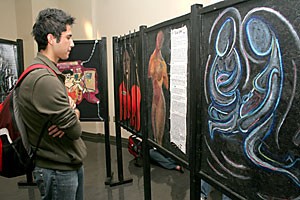One out of every 109 women in America is in prison, either on parole or probation. Seventy-eight percent of all incarcerated women were abused as children.
“”Interrupted Life: Incarcerated Women in the United States,”” a gallery exhibit in the Student Union Memorial Center, speaks volumes about the American prison system as it explores the reality of female incarceration and its effect on families.
Through photos, letters, paintings and prison jumpsuits emblazoned with photographs of incarcerated mothers and accompanying letters written to their children while in jail, the exhibit reveals an eerie scenario of how some women end up in prison.
“”I am 100 percent sure, drugs and alcohol led to my incarceration – just say no!”” wrote M. Caballero on a postcard while incarcerated.
That postcard, along with hundreds of others written from inside 38 women’s prisons, hangs as the centerpiece of the exhibit.
Originally created by New York City curator Rickie Solinger, the exhibit has been traveling for the past two years, finding a home in the SUMC from Dec. 18 to Jan. 27.
“”This exhibit had been planned for about a year before it came to UA,”” said Roula Seikaly, an art history graduate student who works at thegallery.
It was not difficult to schedule and assimilate to the gallery, Seikaly said.
For some students, the exhibit serves as a reminder of how fortunate we are to have come this far in life.
“”There is a lot of emotion in this,”” said creative writing junior Giacomo Palma, who goes by the name Damien. “”The hardest part is that it’s mostly about the kids who are left behind and hard off from the start.””
While standing in front of the only poster in the gallery that provides solutions to current incarceration problems, Palma said he wished there was a larger emphasis of this sort.
On the west wall of the gallery, a chilling photograph of a woman and her child reach out toward a silhouette charted with the words: “”This woman was released from prison five years ago. Still homeless on the streets of Los Angeles, her life has never gotten back on track. There are no services or money for people to get a new start. More and more such people will be released into our communities.””
These statements reiterate the importance of the exhibit, now in its last week at the UA.









